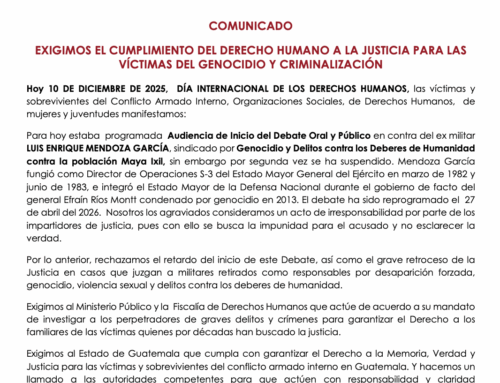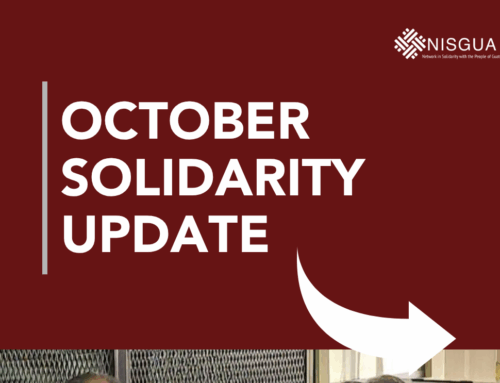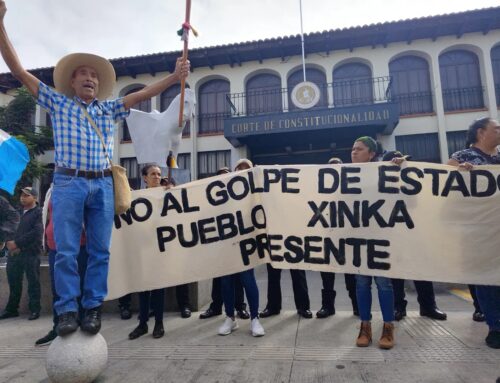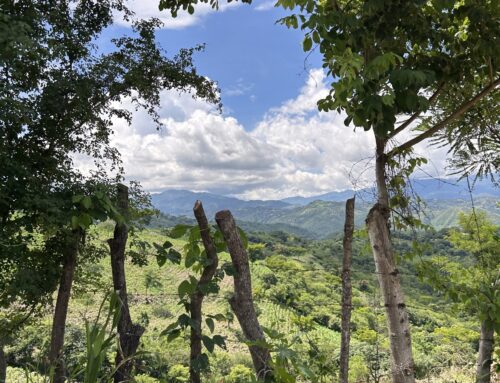On Thursday, January 26, 2012, in a preliminary hearing, General José Efraín Ríos Montt was linked to the ongoing legal process for genocide and crimes against humanity by the first justice for high risk cases, Carol Patricia Flores. Ríos Montt refused to make a statement. Despite the gravity of the charges, the judge ordered house arrest with a bail of 500,000 quetzales, a decision that has been criticized by the Association for Justice and Reconciliation (AJR) and the Center for Human Rights Legal Action (CALDH)(1). The presentation of the indictment is scheduled for March 27th, and the hearing to decide whether the accused will face a public trial is planned for April 12.
This decision comes more than ten years after the first accusation for genocide in Guatemala was filed against the general and his high command, brought by the AJR in 2001. ACOGUATE has accompanied the AJR, plaintiffs in the case, since 2000, and observed the activities within and outside of the Tower of Tribunals on the day of Rios Montt’s preliminary hearing. The hearing took place within a tense atmosphere, as much for the people accompanied, as for human rights organizations.
Many representatives from communities, in large part from the Ixil region, including the municipalities of Santa María Nebaj, San Juan Cotzal, and San Gaspar Chajúl, in the department of Quiché, as well as family members and allies of the accused, human rights organizations, and national and international press, filled the chamber in the Tower of Tribunals. Outside in the Plaza of Human Rights, approximately 400 or 500 people, many who had traveled from their communities the day before, gathered to hear a live transmission of the preliminary hearing of the de facto ex-president and to carry out commemorative activities. Facing the steps of the Supreme Court of Justice, a carpet of flowers spelled out the words, “No more impunity, not yesterday, not today.”
The Armed Conflict Under the De Facto Government of Ríos Montt
General José Efraín Ríos Montt became head of state after dissolving the military junta which had removed Romeo Lucas García through a coup in March 1982.(2) Ríos Montt was overthrown in August 1983 by his Minister of Defense, Oscar Humberto Mejía Víctores. During the 17 months he was in power, Ríos Montt is accused of 11 massacres in the Ixil region, resulting in the deaths of 1,771 women, men, elderly, and children, of which 267 have been identified, and the displacement of more than 29,000 people.(3) According to the Commission for Historical Clarification (CEH), established by the Oslo Accord in 1994 and supported by the United Nations, nearly half of all human rights violations committed during the 36-year armed conflict (1960-1996) were committed in 1982.(4) For nine months of that year, Ríos Montt was the de facto authority.
Background: The National Court of Spain and the Four Military Plans
January 26, 2012 was the first time that Ríos Montt appeared in court to face the charge of genocide. For twelve years, until January 14, 2012, Ríos Montt had enjoyed immunity as a deputy of the Guatemalan Republican Front (FRG) in the Congress of the Republic. The first attempt, in 2006, to take his statement failed: In 1999 Rigoberta Menchú presented an accusation to the National Court of Spain, which, based on the principle of universal jurisdiction, began in 2006 to investigate the crimes of genocide, torture, illegal detention, and crimes against humanity committed in Guatemala between 1962 and 1996.(5)
When a Rogatory Commission arrived in Guatemala in June 2006 to take the testimony of the witnesses and defendants, more than a dozen injunctions from the defense prevented the collection of these statements within the country. As a last resort, Judge Santiago Pedraz from the National Court issued international arrest warrants in July 2006 for the eight defendants, among them Ríos Montt. Nevertheless, in 2007, the Constitutional Court ruled that the arrest warrants and extradition requests were invalid, impeding Judge Santiago Pedraz from interviewing the witnesses in Guatemala. In response, Pedraz invited the witnesses to Spain, and in 2008 some 40 people went in order to give their testimonies. (6)
In order to demonstrate the intentionality that characterizes the crime of genocide (7), the four military plans were solicited that indicated the operational planning: Victoria 82, Firmeza 83, Operation Sofía, and Operation Ixil. In 2009, the Constitutional Court ordered the review of the documents, despite arguments from the defense that the contents were “state secrets,” and that their declassification could jeopardize “the sovereignty and integrity of the Nation”.(8) Nevertheless, the Ministry of Defense only turned over Plan Victoria 82 and part of Firmeza 83, arguing that the others had disappeared.(9)
Then, in December 2009, Kate Doyle, an analyst of the National Security Archive (NSA), verified to the National Court the authenticity of the 1982 Operation Sofía archive, obtained from military intelligence sources in Guatemala.(10) According to the NSA, Operation Sofía was a “deliberate counterinsurgency campaign in the summer of 1982 aimed at massacring thousands of indigenous peasants.” Doyle testified that “we have determined that these records were created by military officials during the regime of Efraín Ríos Montt to plan and implement a ‘scorched earth’ policy on Mayan communities in El Quiché. The documents record the military’s genocidal assault against indigenous populations in Guatemala.” (11) The plan Operation Ixil, published in a military journal in 1982, was never officially handed over.
The National Genocide Case
In the national genocide case against General José Efraín Ríos Montt, de facto president from March 1982 through August 1983, and his high command, ten years have passed since the original presentation of the accusation in June 2001 by the Association for Justice and Reconciliation (AJR), advised by the Center for Human Rights Legal Action (CALDH), before there was any progress.
On June 17, 2011, Héctor Mario López Fuentes, former Army Chief of Staff under the de facto government of Ríos Montt, was captured and linked to the process. The indictment was filed in September 2011. Because of a recusal filed by the defense against Judge Flores for suspicion of bias, the process is currently stalled. The recusal is being heard by the Supreme Court of Justice after CALDH filed a legal recourse contesting the decision issued by the First Chamber of the Court of Appeals.
Arrest warrants have also been issued against three other members of Ríos Montt’s high command. On October 12, 2011, José Mauricio Rodríguez Sánchez, former intelligence chief, was captured and linked to the process. At the same time, Oscar Humberto Mejía Víctores, former minister of defense and president from 1983 to 1986, and Luis Enrique Mendoza García, former director of operations, were declared fugitives from justice.(12) Mejía Víctores turned himself in on October 24.(13) Nevertheless, after various medical examinations, on January 5, 2012, the judge provisionally suspended the legal process against him, given his state of health, and ordered periodic medical evaluations.(14)
In December 2011, given that he would lose his immunity as a deputy on January 14, 2012, Ríos Montt presented himself to the Office of the Prosecutor for Human Rights, in order “to solicit information about a possible criminal investigation against him”,(15) and asked that, in place of a high-profile arrest, he would voluntarily present himself to the court for a preliminary hearing. On January 13, he confirmed the same agreement in front of the First Court for High-Risk Cases, and accordingly the preliminary hearing was scheduled for January 26.
_ _ _
1 AJR / CALDH Press Release, 26 January 2012, Ríos Montt ligado a proceso por genocidio
2 El País, 10 June 1982, El general Rios Montt disuelve la junta militar guatemalteca y se autoproclama presidente del país, http://elpais.com/diario/1982/06/10/internacional/392508025_850215.html
3 El Periódico, 27 January 2012. Ríos Montt, Su casa por prisión. www.elperiodico.com.gt/es/20120127/pais/207096/
4 Commission for Historical Clarification (1999). Guatemala: Memory of Silence. Conclusions and Recommendations. p.24
5 Informe de Observación de la Coordinación del Acompañamiento Internacional (May 2006). Acompañamiento a Defensoras y Defensores de Derechos Humanos que luchan contra la impunidad en Guatemala.
6 Center for Accountability and Justice. The Guatemala Genocide Case. http://www.cja.org/article.php?list=type&type=83
7 According to the Convention on the Prevention and Punishment of the Crime of Genocide to which Guatemala has been party since 1949: “[G]enocide means any of the following acts committed with intent to destroy, in whole or in part, a national, ethnical, racial or religious group, as such: (a) Killing members of the group; (b) Causing serious bodily or mental harm to members of the group; (c) Deliberately inflicting on the group conditions of life calculated to bring about its physical destruction in whole or in part; (d) Imposing measures intended to prevent births within the group; (e) Forcibly transferring children of the group to another group.” Convention on the Prevention and Punishment of the Crime of Genocide, Article 2, 1948. http://www2.ohchr.org/english/law/genocide.htm. The Guatemalan penal code has contained a definition for genocide in Article 376 since 1973.
8 Prensa Libre, 20 July 2007. Desclasificarán planes militares: Sala rechaza amparo interpuesto por Ríos Montt. www.prensalibre.com/noticias/Desclasificaran-planes-militares_0_148787005.html
9 CALDH. Caso contra Alto Mando de Ríos Montt. www.caldh.org/index.php?option=com_content&view=article&id=59&Itemid=76&lang=es
10 NSA, 2 December 2009, Operation Sofia: Documenting Genocide in Guatemala. http://www.gwu.edu/~nsarchiv/NSAEBB/NSAEBB297/index.htm
11 Ibid.
12 AJR / CALDH Press Release, 18 October 2011, Prófugos de la justicia, dos militares acusados de genocidio, http://nisgua.blogspot.com/2011/10/profugos-de-la-justicia-dos-militares.html
13 El Periódico, 24 October 2011.Ex-Jefe del Estado Mayor se entrega tras ser declarado en rebeldía. www.elperiodico.com.gt/es/20111024/pais/202659/
14 Prensa Libre, 6 January 2012. Juzgado suspende proceso, http://prensalibre.com.gt/noticias/Juzgado-suspende-proceso_0_622737749.html
15 El Periódico, 16 December 2011. “Quiero saber si me van a acusar por muertes”. www.elperiodico.com.gt/es/20111216/pais/205185/





Leave A Comment